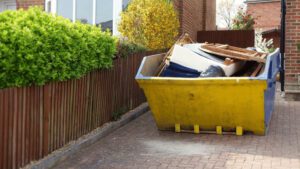Trash out and initial maid services are crucial to making a property marketable, and REO debris removal is a big part of that. REO, or Real Estate Owned, refers to properties that are owned by a bank or lender after an unsuccessful foreclosure sale. Debris removal involves removing all interior and exterior debris, disposing of it properly according to local laws and regulations, and documenting the process accurately. In this blog post, we will go over the necessary tools, safety precautions, and techniques for efficient and effective REO debris removal.
Tools Needed for REO Debris Removal
Before starting the debris removal process, it is important to gather all the necessary tools and safety equipment. These tools include:
- Trailer
- Placard and marker
- Camera
- Trash bags
- Trash cans
- Wheelbarrow
- Broom and dustpan
- Furniture dolly
- Rake
- Shovel
- Hammer
- Cordless drill
- Tape measure
- Ladder
- Safety glasses
- Gloves
- Boots
Safety Precautions
It is crucial to take safety precautions to avoid accidents and injuries during the REO debris removal process. Before starting any work, verify that you are at the correct property, and evaluate the property to identify any unique circumstances or equipment needs. Additionally, you will want to ensure no personal property remains in the home as determined by the individual client’s stated value thresholds. If you encounter a property with personals, provide a bid to remove and store those items for thirty days.
Debris Removal Techniques
Start by taking before photos of the entire property, including exterior and interior photos, with a placard displaying the estimated amount of debris in cubic yards shown in the photo. This will help determine an accurate cubic yard count. Then, when removing debris, take photos of the truck at all stages. Measure the truck and take a before photo of it with a placard illustrating its dimensions. As you fill the truck with debris, take photos of the truck one-fourth full, half full, 3/4 full, and full.
One person should be dedicated to staying near the truck and loading debris. Debris should be separated by recyclables, hazardous material, metal, and other debris when loaded. Larger and heavier debris that cannot be broken up should be placed into the truck first and then surrounded by smaller debris to fill in the empty space. This will salvage valuable space in the truck and reduce ambiguity in estimating cubic yards.
Debris should be removed from the property by starting on the highest level floor, typically the attic, and working your way down to the lowest level floor, which would be the basement if one is present. Use rolling bins or trash cans strapped to dollies to remove the small debris. This improves efficiency and reduces fatigue. Debris should be removed from hallways and stairs for easier traffic flow. In addition, all hooks, nails, and hardware from draperies and blinds must be removed from the walls.
Exterior debris removal involves removing all natural debris, including leaves, loose branches, and twigs. If clients request a bid for tree removal, include the equipment needed for removal, estimated labor hours, disposal costs, and specific details of how you will remove the tree.
Documenting the Debris Removal Process
Once debris has been removed, take after photos from the same angle as the before photos in each room. Photos of debris loaded into the trailer are not acceptable as the only after photos. It is important to accurately document the REO debris removal process to provide proof of work done and ensure that the property is ready for market.
In conclusion, REO debris removal is a crucial part of making a property marketable. It involves removing all interior and exterior debris, disposing of it properly, and documenting the process accurately. Before starting the process, it is important to gather all the necessary tools and safety equipment, take safety precautions, and use efficient debris removal techniques. Documenting the process with before and after photos and accurate cubic yard counts is essential to provide proof of work done and ensure the property is ready for market. By following these steps, you can efficiently and effectively remove debris from REO properties.
